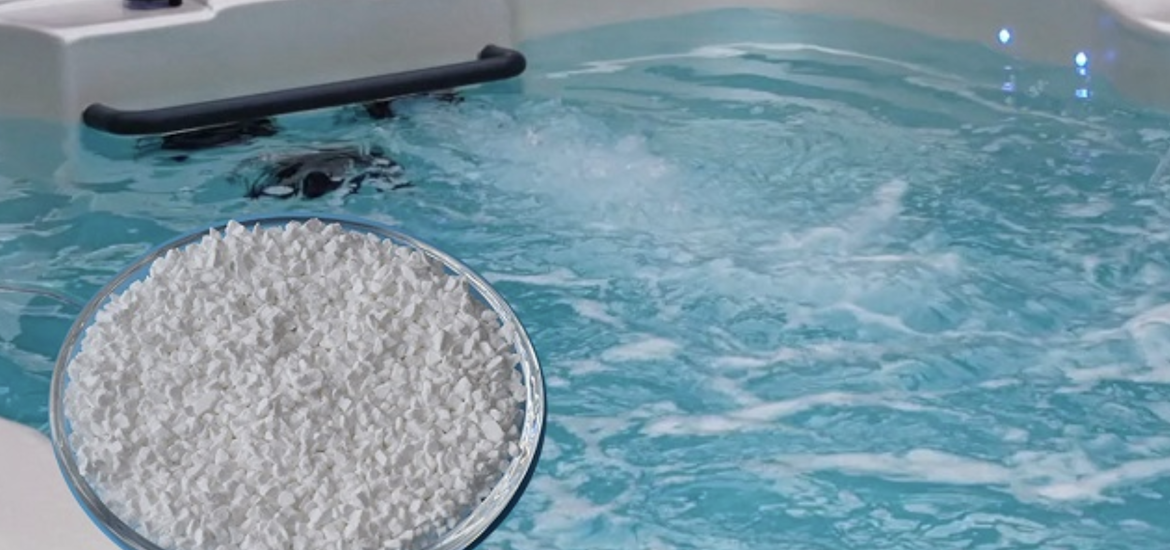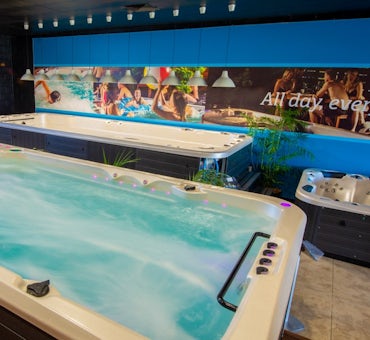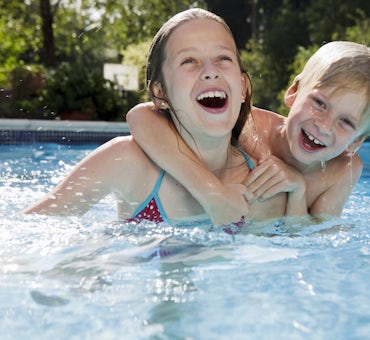Problems with chlorine sanitiser for spa pools (and how to resolve them)
An indepth guide that explains common issues and problems with chlorine sanitiser for spa pools (and how to resolve them)

Chlorine is a powerful and effective disinfectant that is used for many decades for sanitising spa pools, hot tubs, swim spas and swimming pools.
It is used by cities for sanitising drinking water and tap water and has been proven to be safe and effective when used correctly.
The most commonly used type chlorine is sodium dichlor which has a number of advantages for sanitising spa pools and swim spas. It is powerful as a sanitiser so it does not require a large dose to effectively sanitiser your water. Because of this, it is very cost effective.
There are however some disadvantages and problems associated with using chlorine as a spa sanitiser. In this article we’ll discuss some of these problems and how you can address them. This article is designed as a guide to help you understand the pros and cons of chlorine as a spa sanitiser so you can make an informed decision whether it is right for you.
Please note the recommendations in this article are guidelines only and are accurate at the time of writing. You should always follow your spa manufacturer's instructions and the dosage instructions on any chemicals that you use in your spa.
Can too much chlorine damage a hot tub?
Yes if you do use too much chlorine in your hot tub, you will find that the water can become too acidic. This can cause permanent etching and staining on the acrylic shell of your spa.
For this reason, we recommend that you only use the recommended daily dose of chlorine which is 6-10 grams per 1,000L of water in your spa.
Other damage that can be caused by too much chlorine can include premature wear on rubber seals, o-rings and gaskets inside your pumps and plumbing components in your spa.
Plastic components can also be damaged by too much chlorine - this can show up in the form of damage to the filter box face and jet faces.
Please note we always recommend following the manufacturer’s dosage instructions on your chemicals.
Is it safe to get in a spa with high chlorine?
No. It is not recommended to get into a spa if the chlorine level is higher than 3 parts per million on your test strips. Chlorine levels that are higher than this can cause eye irritation, dry skin and even breathing problems for some individuals with other health conditions.
If your chlorine levels are above this level, read on to find out how to get your chlorine level back into the healthy range.
Please note we always recommend following the manufacturer’s dosage instructions on your chemicals.
How do I bring the chlorine level down in my spa?
If your chlorine levels have risen too high, there are two options that we recommend.
1. Let the chlorine levels naturally reduce
Leaving your spa cover off with the jets running will naturally circulate and aerate the water in your spa - allowing the chlorine to naturally ‘gas off’ the top of your spa water. The UV rays in the sunlight also help to reduce the chlorine level in your spa?
2. Drain and refill your spa
Draining and refilling your spa is a viable option if you have over-chlorinated your spa. You can also partially drain and refill a portion of your spa water with fresh water to help dilute the chlorine level.
What happens if there is not enough chlorine in a spa?
Just as too much chlorine is bad for your spa and for your health, not enough chlorine can also cause problems. If you aren’t using enough chlorine sanitiser, bacteria and microorganisms can begin to grow in your spa water - causing a health hazard and affecting the quality of your water.
Signs of insufficient chlorine include foam, scum and cloudy water or a lack of clarity in your water. You may also notice your water taking on a greenish tinge which could indicate the beginning of algae formation.
The recommended daily dosage of chlorine is 6-10 grams per 1,000L of water. (Please note, you should always follow the recommendations on the label of your chemical products).
Can you use pool sanitiser in a hot tub or spa?
No you definitely cannot use pool sanitiser in a spa as it has a completely different chemical makeup. Pool chlorine is designed to work in much lower water temperatures - generally only up to 20 or 25 degrees celsius. Many spas and hot tubs have a water temperature of 35-39 degrees celsius.
In addition to the differing water temperatures, spas and hot tubs generally have an acrylic shell which can be damaged and marked if you use pool chlorine.
In short, ensure you use chlorine sanitiser that is specifically designed for spas and hot tubs.
What is the difference between pool chlorine and spa chlorine?
Pool chlorine is designed for a much larger volume of water, so in many cases comes in a higher concentration. This can result in chlorine levels that are way too high in a spa pool resulting in damage to components in your spa and potentially skin irritation for you and your guests.
Some of the other ingredients in pool chlorine include a stabilising agent which can upset the water balance in your spa, making it difficult to maintain your water clarity.
As we mentioned above, pool chlorine is designed for lower water temperatures, so it may not properly sanitise your warmer spa water - resulting in a potentially hazardous breeding ground for bacteria.
Are chlorine tablets bad for a spa?
Yes chlorine tablets can cause problems in spa pools, hot tubs with acrylic shells. Chlorine tablets are really designed for swimming pools with concrete, tile or fibreglass shells, so it is not recommended to use these tablets to use these in a spa or hot tub. The reason for this is that the floating chlorine dispensers do not evenly distribute chlorine throughout a spa - you can get pockets of chlorine which are highly concentrated in some areas, while other areas of your spa water are not properly sanitised. The floating dispensers tend to get trapped in one position in your spa which causes uneven distribution of sanitiser.
For this reason, we recommend only using granular chlorine powder, which should be dissolved in a bucket or cup of warm water then stirred evenly into your spa water. Turn your circulation pumps off before adding chlorine, then allow the chlorine to dissolve completely for 30 minutes in your water before turning your pumps back on. (Following this process correctly will give you the best results).
Chlorine in the tablet form is also not UV stabilised in many cases. In an outdoor spa, it’s effectiveness is reduced by the sun’s UV rays.
I’m allergic to chlorine - how can I use my spa?
Chlorine can cause issues for some people with sensitive skin and allergies. These issues can include dry or itchy skin, skin irritation
Those with allergies and respiratory problems like asthma may also experience shortness of breath with a chlorine sanitiser. If this is the case, there
If you are unsure about whether chlorine is safe for you, please check with your doctor.
Bear in mind that most drinking water and household tap water in many cities is sanitised with Chlorine. This means that the water that you use for drinking, washing and showering will all have mild traces of chlorine in it.
If you are treating your spa water correctly and following the recommended dosage on your chemical labels, the chlorine levels will most likely be at safe levels
Should I smell chlorine in my spa?
A spa should not have a strong chlorine odour. If you are experiencing a strong chlorine odour in your spa, you may have chloramine gases being released from your spa water.
How do I get rid of the chlorine smell in my spa?
A strong chlorine smell in your spa is not necessarily caused directly by chlorine, but by the byproducts of chlorine called chloramines. Chloramines are released as your chlorine sanitiser is doing it’s work disinfecting your spa water - but there are some things you can do to reduce the odour.
1. Check your water balance.
Your water pH level should be between 7.4 and 7.6. If your pH is outside of this ideal range, adjust your pH with an alkalinity increaser or pH decreases.
2. Shock your spa
If you are smelling an excessive amount of chloramines (a chlorine-like smell) in your spa, then it can indicate that a build up of ammonia has occurred in your spa. This can be caused by lotions, sunscreen, oils, perspiration and urine (lovely!) The ammonia reacts with your chlorine, releasing the chloramine gases (which have the chlorine odour) - all the time, preventing your chlorine sanitiser from working properly.
A shock does of chlorine (25-30g per 1,000L or water) or a chlorine-free shock can neutralize the ammonia, then allowing your sanitiser to work properly again.
After adding the shock dose, leave the cover off and run your jets for 45-60mins to allow the shock to do it’s work and gas off.
Can chlorine in a spa affect those with asthma or respiratory conditions?
The byproducts released from a chlorine sanitiser include chloramines which can cause issues with those with respiratory problems like asthma. Chloramines are generally only produced when there is a water quality issue in your spa.
So, if you are maintaining your spa correctly, keeping your water balanced and sanitised on a regular basis, you shouldn’t have a problem with chloramines in your spa.
If you do have asthma or another respiratory problem, consult your doctor before you enter the spa.
Can spa chlorine cause skin irritation?
For some individuals who have sensitive skin, chlorine can cause irritation of the skin. This can show up as a red rash, itchiness, inflammation or dry, scaly skin.
This can be mitigated by ensuring that your water is balanced correctly and sanitised with the correct amount of sanitiser.
Can I have a chemical-free spa?
No! Spa water is a perfect breeding ground for bacteria and microorganisms, which are unsafe and even dangerous for humans. Without a sanitiser of some sort, your spa water will quickly grow algae, become green or cloudy and unsafe. It is important to use a sanitiser of some sort to kill bacteria and help you maintain crystal clear water.
That being said, there are some good alternatives to chlorine, if you want to consider another sanitiser option. There are also some other water treatment technologies which can be used alongside chlorine to help sanitise your water, meaning you may use a lesser amount of chlorine.
Read on to learn more about these alternative spa water sanitisers.
What are the alternatives to spa chlorine?
Many people ask us; “can you use a spa without chlorine?” The answer is yes you can.
Whether you or a family member have an allergy to chlorine, or you just want to try something different, there are a number of viable sanitiser alternatives available. These include hydrogen peroxide, saltwater, UV light and mineral sanitisers.
Read on to learn more about these options.
Is hydrogen peroxide safe for spa pools?
Yes, hydrogen peroxide in a concentrated solution of between 30% and 35% is a safe and effective sanitiser option for spa pools and swim spas.
Hydrogen peroxide is made from 2 hydrogen atoms and 2 oxygen atoms. When it is added to spa water one of the oxygen atoms reacts with bacteria and organisms in your water, ‘oxidising’ them. Once the reaction is finished, you are simply level with oxygen and water - with no other chemical byproducts and no odour.
Hydrogen peroxide does require more careful maintenance than chlorine, and has a few other drawbacks also. Read our detailed article about all the pros and cons of hydrogen peroxide as a spa sanitiser.
Can I use saltwater in my spa or swim spa?
Saltwater can be used as part of a sanitizing solution for your spa or swim spa. A saltwater sanitising system reacts with salt (sodium chloride) dissolved in your spa water to produce a natural form of chlorine (hypochlorous acid and hypochlorite). This natural chlorine then does it’s work killing bacteria and organisms in your spa water. When it has finished, it returns to the salt form.
Although this is not technically a ‘chlorine-free’ sanitiser, it produces a more natural form of chlorine and generally will have less odour than adding chlorine directly.
Do UV (ultraviolet) lights work in spas and swim spas?
Yes! A UV sanitiser system in your spa works by passing your spa water through a tube and focusing a high intensity UV light on the water. UV light has been proven to be effective at killing bacteria and harmful organisms in water. It is used for the treatment of drinking water in many places.
Note that UV is not a complete replacement for a sanitising chemical, so you will still need to use chlorine or another sanitiser, but you may find that you use less as the UV system is helping you keep your water clean.
Can I use a mineral sanitiser in my spa?
Yes, there are a number of mineral spa sanitiser options available - the most popular is the Nature 2 Spa stick. This uses a blend of silver, zinc and copper minerals to help kill bacteria and algae in your spa. This reduces the load on your primary spa sanitisers.
Nature 2 sticks can also help soften the water in your spa making your water feel smoother and gentler on your skin.
In most cases, you will still need to use a small amount of sanitiser alongside Nature 2 Spa to ensure your water is clean and bacteria-free.
Pros and Cons of Chlorine Spa Sanitiser
Chlorine Spa Sanitiser Pros | Chlorine Spa Sanitiser Cons |
|---|---|
Cost effective | Produces an odour that some find unpleasant |
Powerful and effective at killing bacteria | Can irritate eyes and sensitive skin |
It is readily available | Can aggravate those with allergies, asthma or respiratory conditions |
It is not classified as dangerous goods so easy to transport and store | Can damage components in a spa if the correct dosage is not maintained |
Safe for handling |
Summary
Now you will have a clear understanding of some of the issues that you may face when sanitising your spa with chlorine. This will help you make an informed decision to determine if chlorine is the right choice for sanitising your spa.
If you have any questions about chemical choices for your spa, our team have over 25 years of experience in the spa industry and can assist you with any questions you may have.


